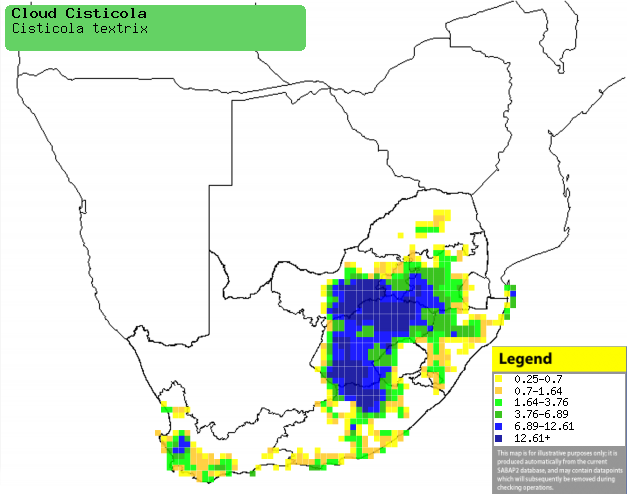|
Cisticola textrix (Cloud
cisticola)
Gevlekte klopkloppie [Afrikaans]; Igqaza (also applied to
Wing-snapping cisticola) [Xhosa]; iBhoyibhoyi (also applied to Wing-snapping
cisticola) [Zulu]; Motintinyane (generic term for cisticolas and prinias) [South
Sotho]; Tinktink-graszanger [Dutch]; Cisticole pinc-pinc [French]; Pinkpink
[German]; Fuinha-das-nuvens [Portuguese]
Life
> Eukaryotes >
Opisthokonta
> Metazoa (animals) >
Bilateria >
Deuterostomia > Chordata >
Craniata > Vertebrata (vertebrates) > Gnathostomata (jawed
vertebrates) > Teleostomi (teleost fish) > Osteichthyes (bony fish) > Class:
Sarcopterygii (lobe-finned
fish) > Stegocephalia (terrestrial
vertebrates) > Tetrapoda
(four-legged vertebrates) > Reptiliomorpha > Amniota >
Reptilia (reptiles) >
Romeriida > Diapsida > Archosauromorpha > Archosauria >
Dinosauria
(dinosaurs) > Saurischia > Theropoda (bipedal predatory dinosaurs) >
Coelurosauria > Maniraptora > Aves
(birds) >
Order: Passeriformes > Family: Cisticolidae
> Genus: Cisticola
Distribution and habitat
Although it has isolated populations across Angola,
southern DRC and Zambia, it is most common in South Africa. Here it prefers open
grassland with patches of bare soil, both tall and short varieties, occasionally
in love grass (Eragrostis) pastures and clumps of restios.
|
 |
|
Distribution of Cloud cisticola in southern Africa,
based on statistical smoothing of the records from first SA Bird Atlas
Project (©
Animal Demography unit, University of
Cape Town; smoothing by Birgit Erni and Francesca Little). Colours range
from dark blue (most common) through to yellow (least common).
See here for the latest distribution
from the SABAP2. |
Food
It mainly eats invertebrates, especially grasshoppers (Orthoptera)
but also
spiders, foraging in the undergrowth and bare soil.
Breeding
- The nest is a ball shape with a side entrance, built of dry grass and
lined with plant down. It is typically placed close to the ground in a grass
tuft, the leaves of which are incorporated into then nest, effectively
concealing it.
- Egg-laying season is from August-March.
- It lays 2-4 eggs, which are incubated for about 14 days.
- Little is know about the chicks, other then that they leave the nest
after about 15-16 days.
Threats
Not threatened, although transformation of grasslands to
croplands in South Africa's central plateau is cause for concern. Also, it has
not adapted well to the introduction of alien plants, housing development and
agriculture in the Western Cape.
References
-
Hockey PAR, Dean WRJ and Ryan PG 2005. Roberts
- Birds of southern Africa, VIIth ed. The Trustees of the John Voelcker
Bird Book Fund, Cape Town.
|
